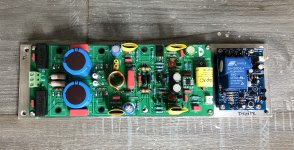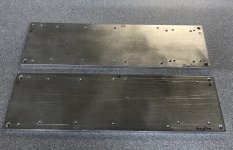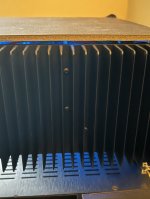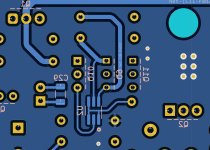Thank you, Stef, I will most likely use this external coil pcb.
Do you have anything to test the coil?
I had time to work a little on the Q17 Turbo. All holes are done. 😉
The Tap Machine is awesome. I just spent a little hour tapping all those holes.
Stef.
Attachments
Last edited:
Sweet work, I’m envious Stef! I was busy most of a Saturday drilling and tapping 😩. I know my amplifier building will not stop, it may be time to invest in a tool to save time, which when converted IS worth money😉.
Kudos to you fearless amplifier builders that successfully do your own thread tapping. I’ve been scared off of tapping aluminum from the stories of snapped taps and Swiss cheese panels/heat sinks in this forum. ☺️
I have no shame in drilling holes and using machine screws with nuts, instead. Time is indeed valuable, Vunce.
I have no shame in drilling holes and using machine screws with nuts, instead. Time is indeed valuable, Vunce.
Attachments
Hello Stef, do you mean the verification of the 1.2uH inductance? If any further specialized measurement is needed, I can very likely do it, it is merely a matter of finding the time. I have access to literally any test equipment from d.c. to THz.Do you have anything to test the coil?
Hello!
I published version 1.0.1 of the Q17-TURBO.
I did not print myself a PCB of this version 1.0.1 so use with caution.
The Q17-TURBO 1.0 have been archived in https://github.com/stefaweb/Q17-a-QUAD405-audiophile-approach/tree/main/Q17-TURBO Archives.
Regards,
Stef.
ps mcsontos: Yes, it would be good if you could test the coil in order to be sure of its value (or send me one unit and I will test it).
I published version 1.0.1 of the Q17-TURBO.
- Added U2 footprint on back PCB (NDC7003P replace Q9 and Q11).
- Updated some silkscreen on back PCB.
- Updated schematic with new parts.
I did not print myself a PCB of this version 1.0.1 so use with caution.
The Q17-TURBO 1.0 have been archived in https://github.com/stefaweb/Q17-a-QUAD405-audiophile-approach/tree/main/Q17-TURBO Archives.
Regards,
Stef.
ps mcsontos: Yes, it would be good if you could test the coil in order to be sure of its value (or send me one unit and I will test it).
Attachments
Last edited:
Hi,Hello Stef, do you mean the verification of the 1.2uH inductance? If any further specialized measurement is needed, I can very likely do it, it is merely a matter of finding the time. I have access to literally any test equipment from d.c. to THz.
Could you also measure an amplifier module of mine? I would be interested to see how it performs in terms of distortion and IMD, I don't have any measuring equipment that has sufficient low distortion for this. I would also be very interested in measuring the transfer function of square wave signals. Another aspect is the measurement of the frequency response above 100kHz, as this gives information about possible interferences, but also limits of the amplifier.
Do you have access to laboratory measurement equipment that can do this? Are you interested in performing such measurements?
Regards Tim
Dear Stef and Tim,
currently I am studying this project from the thread, trying to understand its nuts and bolts before I get to it (I know that it is designed by Tibi as a plug-and-play module but understanding every now and then what we actually do is so pleasantly rewarding...). I have already purchased the transistor set (better have them, who knows if and when they disappear from the market again).
I will most likely come to personalizing my amplifier boards (so that they fit into my modular diy integrated amp with already given peripherials and space restrictions) and actually building the amp around Q3-Q4 of 2023, after I have finished my ongoing diy audio projects. When my journey starts, I will promptly feed everything, including layouts, photos, measurements and listening experiences back here.
I do have access to lab equipment, only I have never performed dedicated audio measurements, so I will need to familiarize myself with the specific approaches first. Also, as a matter of workplace responsibility, I would start out with amplifier boards which I have tortured enough at home, so I trust that they will not go crazy and harm the test equipment, which may be several zeros more expensive than the subject of the test.
Best, Miklos
currently I am studying this project from the thread, trying to understand its nuts and bolts before I get to it (I know that it is designed by Tibi as a plug-and-play module but understanding every now and then what we actually do is so pleasantly rewarding...). I have already purchased the transistor set (better have them, who knows if and when they disappear from the market again).
I will most likely come to personalizing my amplifier boards (so that they fit into my modular diy integrated amp with already given peripherials and space restrictions) and actually building the amp around Q3-Q4 of 2023, after I have finished my ongoing diy audio projects. When my journey starts, I will promptly feed everything, including layouts, photos, measurements and listening experiences back here.
I do have access to lab equipment, only I have never performed dedicated audio measurements, so I will need to familiarize myself with the specific approaches first. Also, as a matter of workplace responsibility, I would start out with amplifier boards which I have tortured enough at home, so I trust that they will not go crazy and harm the test equipment, which may be several zeros more expensive than the subject of the test.
Best, Miklos
Just confirmed to myself that FQA46N15 & IXTH48P20P make a better pair. Both have almost same Vgs(threshold) and transconductance.
Bass is deeper and amplifier get more control at any volume.
Another nice discovery are Wurth Electronic electrolytics. I like them a lot. To my ears, they sound better than anything I have used so far in this position.
View attachment 1156533View attachment 1156534View attachment 1156536
…
Now after more than one week with this pair, I must say there is no way to comeback at FQA36P15.
@Vunce
Thank you for your feed back and congratulation for your build !
Yes, Q17 is one amplifier to keep and the best amplifiers I ever built.
I already compared this amplifier with some 5 digit $ commercial amplifiers and Q17 is by far the best.
When I say "by far" mean there is a very audible difference in dynamics, resolution, 3D soundtstage, clarity and distorison. Yes, distorsion as well.
Q17 is a class B amplifier but have trashed all class A amplifiers it was A/B compared.
Well, we need to learn something from this.
About hum. Please use shielded cable on input.
Hello,
I got IXTH48P20P and made measurements, also FQA36P15 and FQA46N15 for comparison
Regards Tim
Hi,
I installed the IXTH48P20P and have been listening to it for a few days. The two amplifiers are essentially the same, but the large electrolytic capacitors are from different brands, which also has an influence. Therefore, my conclusion is that I can say that the IXTH48P20P are not very different from the FQA36P15. I only have a pair of power mosfet each. When building with the IXTH48P20P I paired the FQA46N15 related to Vgs(on). For me, the IXTH48P20P are an equivalent replacement, but I can't hear any "advantage" for me, both MosFETs seem to be too similar.
Regards Tim
Two juxtaposed and very different opinions. Interesting.
I would encourage both of you (and others) to also make comparisons to other known amplifier designs or else the subjective comparisons (without objective data, i.e. spectral distortion measurements, etc…) become a very circuitous method of comparing.
What 5 digit amplifiers are these? Is it okay to name them publicly?
Best,
Anand.
Hi Stef,Hello!
I published version 1.0.1 of the Q17-TURBO.
https://github.com/stefaweb/Q17-a-QUAD405-audiophile-approach/tree/main/Q17-TURBO 1.0.1
- Added U2 footprint on back PCB (NDC7003P replace Q9 and Q11).
- Updated some silkscreen on back PCB.
- Updated schematic with new parts.
I did not print myself a PCB of this version 1.0.1 so use with caution…….
I don’t see the updated Turbo 1.0.1 gerbers on your github page?
The Turbo 1.0 are still there, I must not be looking in the correct spot.
As an example, I will mention one of my favorites of the amplifiers, the Musical Fidelity NuVista, one of the great models, with their special preamp. Such an amplifier sounds good compared to the homemade Q17, a touch more pointed perhaps. In this comparison, the Q17 can offer more balance in fine resolution, despite the impressive bass foundation. Here I must say, however, that the test speakers were only Focal Sopra 2 speakers, so also a good pleasant sounding speaker, but neither bass potent nor special in acoustic imaging.Two juxtaposed and very different opinions. Interesting.
I would encourage both of you (and others) to also make comparisons to other known amplifier designs or else the subjective comparisons (without objective data, i.e. spectral distortion measurements, etc…) become a very circuitous method of comparing.
What 5 digit amplifiers are these? Is it okay to name them publicly?
Best,
Anand.
There are of course many amplifiers that clearly fall behind the Q17, to list them here would perhaps be borderline (and I have not kept a list of names and types, I run regular comparisons of different listeners to work my way up to the optimum).
An important aspect in the test listening of the MosFET is that I prefer the FQA with one pair of power transistors, Tibi prefers the IX with two pairs. Here is my thesis, since the IX are subtly dull in sound - which should not be overinterpreted - this is for me a sign that these as two pairs probably also play more balanced than the FQA in this form. This is a question of the correction function of the circuit, which can undoubtedly work more precisely with one pair than with two pairs, of course related to the errors of each individual Mosfet.
I can describe it another way: the errors take place at very small deviations from the setpoint, and the IXs here seem to be more imprecise in these details. But two FQAs play against each other more clearly than two IXs, if my thesis is correct that the IXs are basically inaccurate in these last details. That is at least my understanding of it and therefore I find the statement of me and Tibi not contradictory, but understandable.
Regards Tim
Last edited:
Hi Stef,
I don’t see the updated Turbo 1.0.1 gerbers on your github page?
The Turbo 1.0 are still there, I must not be looking in the correct spot.
Oops, I uploaded all the source files but forgot the principal, the Gerber files. 😵
Done.
https://github.com/stefaweb/Q17-a-QUAD405-audiophile-approach/tree/main/Q17-TURBO 1.0.1
Gerber-Q17-TURBO-1.0.1.zip
Stef.
How does the performance compare to the wolverine? Has anyone made a comparison?
Great perspective.As an example, I will mention one of my favorites of the amplifiers, the Musical Fidelity NuVista, one of the great models, with their special preamp. Such an amplifier sounds good compared to the homemade Q17, a touch more pointed perhaps. In this comparison, the Q17 can offer more balance in fine resolution, despite the impressive bass foundation. Here I must say, however, that the test speakers were only Focal Sopra 2 speakers, so also a good pleasant sounding speaker, but neither bass potent nor special in acoustic imaging.
There are of course many amplifiers that clearly fall behind the Q17, to list them here would perhaps be borderline (and I have not kept a list of names and types, I run regular comparisons of different listeners to work my way up to the optimum).
An important aspect in the test listening of the MosFET is that I prefer the FQA with one pair of power transistors, Tibi prefers the IX with two pairs. Here is my thesis, since the IX are subtly dull in sound - which should not be overinterpreted - this is for me a sign that these as two pairs probably also play more balanced than the FQA in this form. This is a question of the correction function of the circuit, which can undoubtedly work more precisely with one pair than with two pairs, of course related to the errors of each individual Mosfet.
I can describe it another way: the errors take place at very small deviations from the setpoint, and the IXs here seem to be more imprecise in these details. But two FQAs play against each other more clearly than two IXs, if my thesis is correct that the IXs are basically inaccurate in these last details. That is at least my understanding of it and therefore I find the statement of me and Tibi not contradictory, but understandable.
Regards Tim
I think this is the MF NuVista you are talking about: https://upscaleaudio.com/products/musical-fidelity-nu-vista-800-integrated-amplifier
Thank you again,
Anand.
Wolverine is on my “to build” list, so no subjective comparison possible yet. Still want to tweak with Q17 before I start that one.How does the performance compare to the wolverine? Has anyone made a comparison?
I have a few questions about the design?
- Am I correct that the Q17 is a composite amplifier, with the outer FB loop based around the OPA1641?
- What is the purpose of the block that uses Q7, Q8, Q9, Q11?
- What is the purpose of Q13, Q14?
- What is the power limit if I just want a single pair of mosfets at the output.
- I know this next question may be subjective, but if I use a single pair of MOSFETs at the output, which sound good (best is in the ear of the beholder)
- There is no DC servo right?
Last edited:
Hi!
You can read this doc from Tibi. The operation of each element is detailed there.
https://github.com/tiberiuvicol/Q17-audiophile-amplifier/blob/main/Project description.pdf
Regards,
Stef.
You can read this doc from Tibi. The operation of each element is detailed there.
https://github.com/tiberiuvicol/Q17-audiophile-amplifier/blob/main/Project description.pdf
Regards,
Stef.
Doe you have an updated link for the SMPS?About power supply.
The best is with trafo, synchronous rectifiers and MLytic caps.
If you go for SMPS, I recommend this one.
It has very low noise, low footprint, not expensive and it was tested by me. It will work just fine with 2 x Q17 with 3 pairs. Go for +/-60V.
Regards,
Tibi
- Home
- Amplifiers
- Solid State
- Q17 - an audiophile approach to perfect sound




